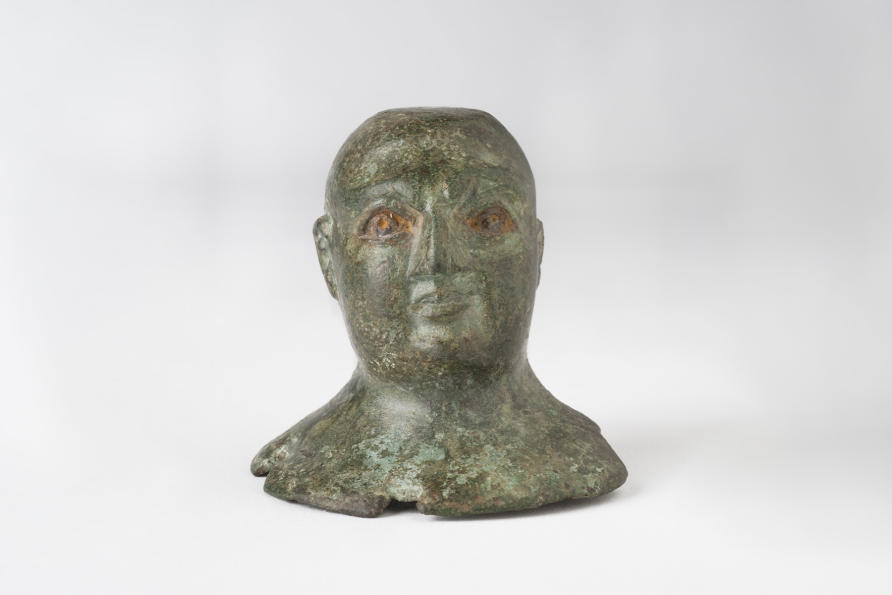Beleza, vinho e morte no mundo antigo
Uma nova exposição oferece insights sobre as vidas ocultas de mulheres, crianças, escravos e artesãos do antigo mundo greco-romano
Por Dra. Tamara Lewit e Dra. Caroline Tully, Universidade de Melbourne
Imagine uma mulher olhando para seu rosto em um pequeno espelho de latão altamente polido. Ela nunca viu o seu corpo inteiro – nenhum espelho é tão grande nos mundos grego e romano.
Ela embranquece o rosto com giz em pó e avermelha as bochechas com uma tintura feita da planta mais louca. Seus dedos mergulham em um prato redondo decorado com um fantástico monstro marinho com cabeça de cavalo.
Raramente podemos vislumbrar as salas de trabalho, os quartos e as enfermarias de povos tão antigos ou a vida quotidiana oculta de mulheres, crianças, escravos ou artesãos que deixaram poucos vestígios e são muitas vezes ignorados na escrita da história.
Vidas Antigas: Insights da Coleção de Clássicos e Arqueologia, uma nova exposição em duas partes desenvolvida pelo Museu de Arte Ian Potter no Old Quad da Universidade de Melbourne, oferece uma rara janela para essas vidas.
O prato do monstro marinho é um dos muitos pequenos objetos pessoais apresentados em uma parte da exposição: Amor et Mors: Recipientes para o Belo Corpo na Vida e na Morte.
Em vez de giz e tinta, talvez a mulher diante do espelho esteja usando chumbo branco venenoso e cinábrio escarlate (sulfeto de mercúrio) em seus esforços para realçar sua beleza.
O poeta romano Ovídio sugere uma mistura de cevada líbia esmagada, ervilhaca amarga, ovos e os primeiros chifres de um veado, misturada com bulbos de narciso e mel, para que “qualquer mulher que aplique este tratamento em seu rosto brilhe mais suavemente do que o seu próprio. espelho".
Tal mistura teria sido armazenada em uma pyxis, uma pequena caixa cilíndrica ou convexa com tampa, decorada com animais como esfinges e leões e estampada com manchas, quadrados e rabiscos.
As pessoas não queriam apenas parecer bonitas, mas também cheirar divinamente. Um homem untava-se com perfume de cardamomo e óleo perfumado para cabelo em um frasco de vidro em miniatura – talvez um novo tipo de frasco, moldado por artesãos com seu hálito.
O vidro soprado foi inventado no Oriente Próximo no primeiro século AEC (a evidência mais antiga foi encontrada em Jerusalém) e foi trazido para Roma por artesãos e escravos da região.
Os perfumes antigos eram feitos com óleo de oliva, amêndoa ou gergelim misturado com rosa perfumada, coentro ou tomilho selvagem. Os perfumes mais caros continham incenso exótico, mirra, canela ou cássia, trazidos da Arábia e da Índia. O patchouli indiano foi descoberto recentemente em um antigo frasco de perfume na Espanha.
Perfume e beleza não eram apenas para os vivos, mas também para os mortos. Óleos perfumados e unguentos eram usados para embelezar o cadáver e eram oferecidos no túmulo.
O vinho era outra oferta importante, dada aos mortos durante os funerais ou despejada no túmulo através de buracos ou tubos nos aniversários dos falecidos.
A segunda parte da nossa exposição, Branco, Tawny, Vermelho Sangue, Preto: Vinho nos Mundos Grego e Romano, explora como as oferendas de vinho aos deuses também eram uma parte essencial da religião, servidas em santuários domésticos todos os dias e em ocasiões especiais. como retornar de uma viagem.
As moedas expostas mostram divindades e imperadores realizando esses ritos, que também eram realizados pelos mais humildes pescadores, jovens ou donas de casa de fazendas.
O vinho foi amplamente utilizado na medicina. Um manual romano de remédios caseiros recomenda gargarejar esterco de pombo moído ou milípedes esmagados em vinho para amígdalas doloridas.
Vinhos de ervas feitos com hortelã, erva-doce e absinto (o principal ingrediente do absinto moderno) eram usados para curar doenças, incluindo tosse e dores de estômago.
Um tratado grego até recomenda uma injeção de vinho misturado com lagarto picado como afrodisíaco para cavalos.
Mas o vinho também era uma parte universal da dieta de todos – até mesmo das crianças. Os escritores médicos recomendavam que os bebês fossem desmamados com pão amolecido em vinho doce, pois sem refrigeração o leite estragaria facilmente.
Dr Caroline Tully and Dr Tamara Lewit Picture a woman gazing at her face in a small mirror of highly polished brass. She has never seen her whole body – no mirror is that large in the Greek and Roman worlds. She whitens her face with powdered chalk and reddens her cheeks with a dye made from the madder plant. Her fingers dip into a round dish decorated with a fanciful horse-headed sea monster. We can seldom glimpse the workrooms, bedrooms and sickrooms of such ancient people or the hidden everyday lives of women, children, slaves or artisans who have left little trace and are often ignored in the writing of history. Ancient Lives: Insights from the Classics and Archaeology Collection, a new two-part exhibition developed by the Ian Potter Museum of Art at the University of Melbourne’s Old Quad, gives a rare window into these lives. The sea-monster dish is one of the many tiny, personal objects featured in one part of the exhibition: Amor et Mors: Vessels for the Beautiful Body in Life and Death. Instead of chalk and dye, perhaps the woman at the mirror is using poisonous white lead and scarlet cinnabar (mercury sulphide) in her efforts to enhance her beauty. The Roman poet Ovid suggests a mixture of crushed Libyan barley, bitter vetch, eggs and the first horns of a stag, mixed with narcissus bulbs and honey, so that “any woman who applies this treatment to her face will gleam more smoothly than her own mirror”. Such a mixture would have been stored in a pyxis, a small cylindrical or convex box with a lid, decorated with animals like sphinxes and lions and patterned with spots, squares and squiggles. People not only wanted to look beautiful but also to smell divine. A man would anoint himself with cardamon perfume and scented hair oil from a miniature glass bottle – perhaps a new type of bottle, shaped by artisans with their breath. Blown glass was invented in the Near East in the first century BCE (the earliest evidence having been found in Jerusalem) and was brought to Rome by artisans and slaves from the region. Ancient perfumes were made using olive, almond or sesame oil mixed with fragrant rose, coriander or wild thyme. The most expensive perfumes contained exotic frankincense, myrrh, cinnamon or cassia, brought from as far as Arabia and India. Indian patchouli was recently discovered in an ancient perfume bottle in Spain. Perfume and beauty were not only for the living but also for the dead. Fragrant oils and unguents were used to beautify the corpse and were offered at the grave. Wine was another important offering, given to the dead during funerals or poured into the tomb through holes or tubes on the birthdays of the deceased. The second part of our exhibition, White, Tawny, Blood-red, Black: Wine in the Greek and Roman Worlds, explores how wine offerings to the gods were also an essential part of religion, poured at household shrines every day and on special occasions such as returning from a journey. Coins in the exhibition show deities and emperors performing these rites, which were also carried out by the humblest fishermen, young girls or farm housekeepers. Wine was used extensively in medicine. A Roman handbook of home remedies recommends gargling ground pigeon dung or crushed millipedes in wine for sore tonsils. Herbal wines made with mint, fennel and wormwood (the main ingredient of modern absinthe) were used to cure ailments including coughs and stomach upsets. One Greek treatise even recommends an injection of wine mixed with chopped up lizard as a horse aphrodisiac. But wine was also a universal part of the diet for everyone – even children. Medical writers recommended that babies be weaned using bread softened in sweet wine, since without refrigeration milk would easily spoil. Wine was always drunk diluted with at least three or four parts of water, except for religious rituals. Drinking water was often contaminated and was safer when mixed with wine, the acidic and alcohol content killing pathogens. Sour wine, which was virtually vinegar, was distributed as rations to Roman soldiers but would be considered undrinkable today, and slaves drank wine-like drinks made from the skins and pips of grapes soaked in water. Athletes were advised to drink wine only moderately. Wine is frequently referred to in the Christian Gospels, and the wine cup Jesus used at the ‘Last Supper’ came to be called the Holy Grail. According to medieval poetry and legend, it was also used to collect his blood and was much sought by the crusaders as a holy relic. Early Christian devotion is represented in the exhibition by a Tunisian plate fragment stamped with the image of a woolly lamb (a common early Christian symbol). Who stamped it and why? Was the artisan expressing piety or cleverly taking advantage of demand from adherents of this new religion? Perhaps its users felt protected by this sacred symbol as they reclined to dine, reaching into the communal dish of food with their fingers, as was the custom. Cups and jugs, gold coins and terracotta statuettes, a marble cupid, a bronze wrestler, glass bottles and cosmetic pots speak to us with the voices of ancient people about their intimate lives. The exhibition Ancient Lives: Insights from the Classics and Archaeology Collection is jointly curated by Dr Caroline Tully and Dr Tamara Lewit, and presents about 100 objects from the University of Melbourne Classics and Archaeology Collection. The exhibition forms part of the Ian Potter Museum of Art’s artistic program and is presented at the Old Quad while the Potter is undergoing transformation of its entrance and teaching spaces. It is open at the Old Quad, the University of Melbourne, Parkville, from 24 July 2023 – 17 May 2024, Monday to Friday 10-5. Entry is free. There are free Open Day curators’ talks at 11.30am on Sunday 20 August 2023. Banner: The serene face of a dead woman, lips tinted pink and eyes outlined with kohl, gazes at us from this mummy mask. Installation view, Ancient Lives, Old Quad, 2023. Courtesy of Museums and Collections Department, the University of Melbourne. Photo: Christian Capurro.Beauty, wine and death in the ancient world
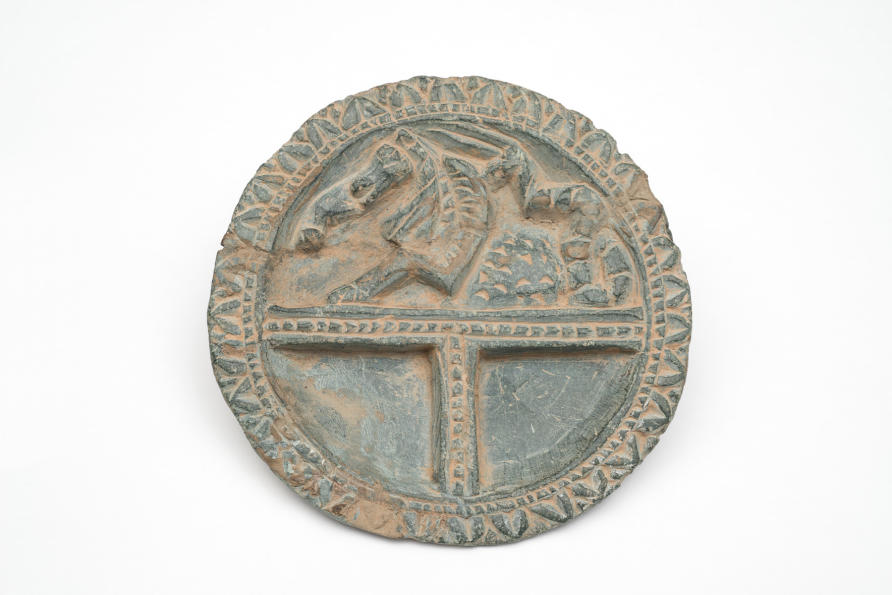
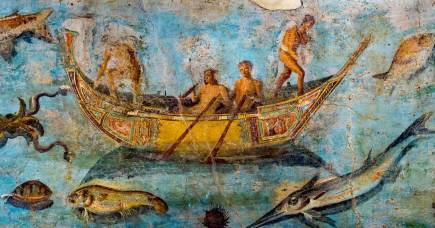
All rivers lead to Rome
LIFE, DEATH AND BEAUTY
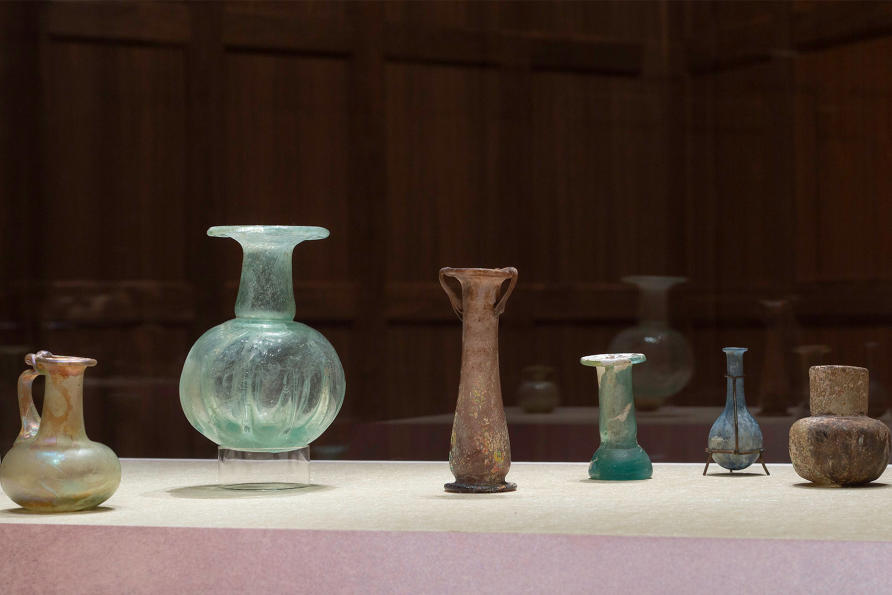
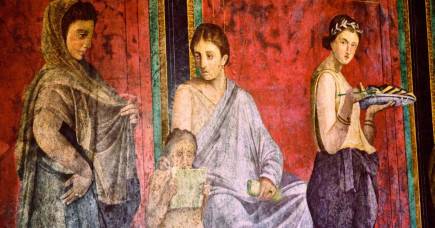
Happy ancient Roman Mother's Day
WINE FOR THE LIVING AND THE DEAD – AND BABIES
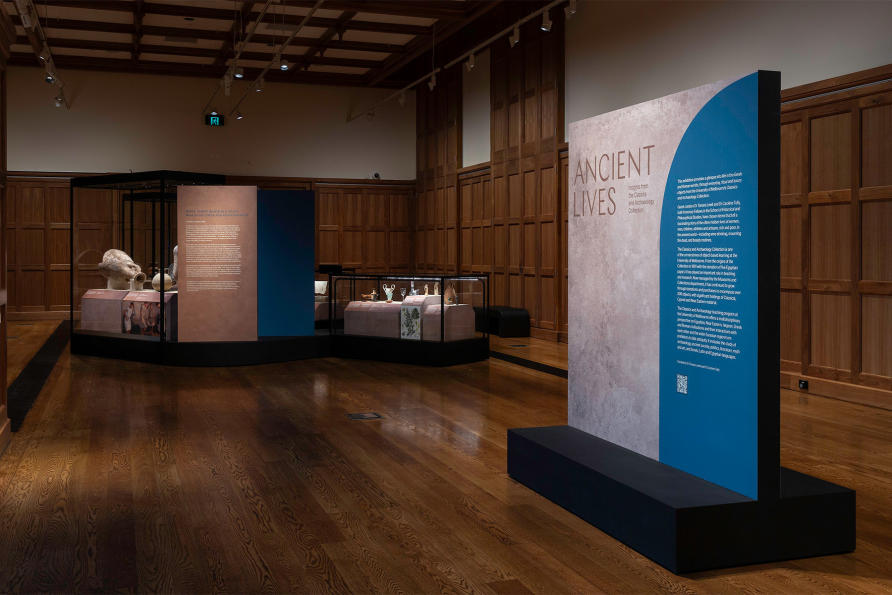
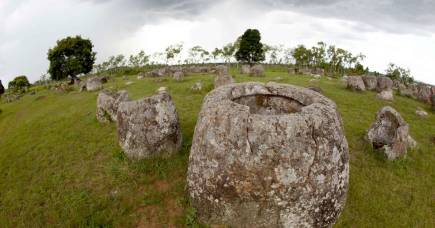
Laos jars are slowly revealing their secrets
